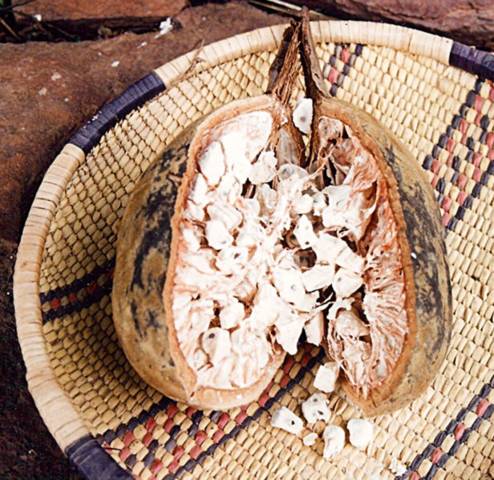
Baobab fruit. Source: wikipedia.
Self magazine did a feature on baobab proclaiming it the next big thing, with more vitamin C than oranges, more calcium thank milk, and more fiber than you can imagine. Here's the funny thing: I have been obsessed with baobab since I first tasted it in Mali's arid hinderlands nearly ten years ago.
The baobab tree is a signature sight in West Africa: its thick, squat trunk erupts suddenly into a wiry tangle of thin branches. It grows in arid regions where few other trees grow, providing needed shade to crops, livestock, and people. As I hiked across the stunning Dogon region of Mali, we would often pass young shepherd boys finding respite from the baking noon sun under the shade of the baobab's trunk.
One afternoon we found some of the baobab pods and cracked them open. The interior fruit was as arid as the surrounding landscape: a pale creamy color, desiccated and cracked with fissures and air pockets throughout. Dubious, at the urging of our guide I put a piece in my mouth. The first experience of the texture was just like the astronaut ice cream I sometimes enjoyed on trips to the science museum. The delicate porous structure began to melt in my mouth, turning from dry and firm into an explosion of flavor that was reminiscent of citrus with a floral note. Was there the subtle suggestion of pineapple in there too? We debated the way to describe the flavor and eagerly worked our way through several pods of baobab.
At the time, I didn't know I was eating the next big superfruit ten years ahead of fashion. I just knew it was delicious.
But it wasn't simply that it was delicious. It was also that it was rare. In the West we are so spoiled in the age of the massive super market, with foods flown and trucked in from all over the globe, that we rarely experience the rarity of food. We get, at best, hints of it through local seasonality: the breathtaking perfection of a Southern peach grown miles from your home in the height of the season. As you eat it, as the juice runs down your chin and fingers, there is a small part of you that knows you will never get this again until next year. That no forlorn grocery peach in October is going to compare to the splendor of this June peach in Georgia. So you eat slowly, and your brain tingles with the effort of memorizing every curve and turn of its flavor.
THAT is what tasting baobab was like, only it has been ten years since I have had the flavor.
I have no idea if the nutritional powders that they will inevitably make from this will compare to the flavor of the fruit itself, but if you get a chance to try baobab, don't hold back. And if you find it at a store near you, please let me know!

Wow! I'm now on the hunt for this fruit, I admittedly have never heard about! Thanks for this post and sharing the info!!!
ReplyDeletexo Emily
I have never heard of this but am deffo going to find it and try it, thanks.
ReplyDeleteThanks for sharing this article about Baobab: the next superfruit.
ReplyDeleteMike @ Gourmet Food
pagina muy buena con recetas y productos gourmet, para todo el mundo, mixtura gourmet
ReplyDeleteGenuinely fascinating. I'd always thought of the Baobab as a completely hostile tree and assumed the fruit was as tough and uninviting as the tree. I will keep an eye out for it and let you know if I find any and if I like it as much as you do!
ReplyDelete